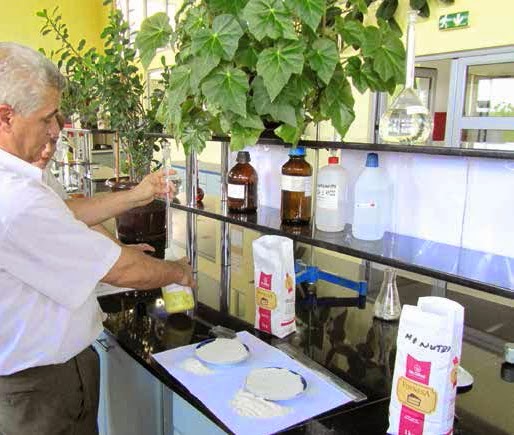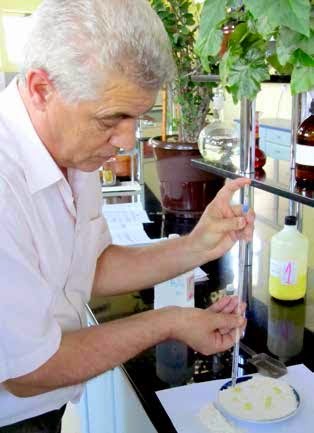Flour millers in three countries demonstrate ‘rigorous’ fortification monitoring
by Sarah Zimmerman, Food Fortification Initiative
First published in Milling and Grain, February 2015
Three recently completed case studies have verified that industrial flourmills in Chile, Indonesia, and the Republic of South Africa (RSA) have rigorous internal controls to confirm that their products comply with country standards for fortification. While other types of monitoring varied considerably, the studies show that milling leaders have developed standard operating procedures to maintain and improve internal quality systems.
“We are pleased to see that these flour millers are at the forefront of ensuring that their customers receive the health benefits from fortification,” said Helena Pachón, Senior Nutrition Scientist for the Food Fortification Initiative (FFI). The studies are a collaborative effort between UNICEF, FFI, and the U.S. Centers for Disease Control and Prevention.
Research for the case studies included interviewing government personnel responsible for monitoring fortification and visiting mills, bakeries, food retail outlets, inspection laboratories, and companies that produce vitamin and mineral premix. The authors found that the industry had instituted regular physical and visual control points. Industry procedures used for internal monitoring in the three countries included:
Check weighing the premix feeder. This is when a miller weighs the amount of premix discharged by the premix feeder over one to two minutes then compares the amount to the weight of premix expected to be discharged over that period.
Ensuring that the feeder is working properly. This involves confirming that the feeder has adequate amounts of premix and that it is delivering the required quantity of premix.
by Sarah Zimmerman, Food Fortification Initiative
First published in Milling and Grain, February 2015
Three recently completed case studies have verified that industrial flourmills in Chile, Indonesia, and the Republic of South Africa (RSA) have rigorous internal controls to confirm that their products comply with country standards for fortification. While other types of monitoring varied considerably, the studies show that milling leaders have developed standard operating procedures to maintain and improve internal quality systems.
“We are pleased to see that these flour millers are at the forefront of ensuring that their customers receive the health benefits from fortification,” said Helena Pachón, Senior Nutrition Scientist for the Food Fortification Initiative (FFI). The studies are a collaborative effort between UNICEF, FFI, and the U.S. Centers for Disease Control and Prevention.
Research for the case studies included interviewing government personnel responsible for monitoring fortification and visiting mills, bakeries, food retail outlets, inspection laboratories, and companies that produce vitamin and mineral premix. The authors found that the industry had instituted regular physical and visual control points. Industry procedures used for internal monitoring in the three countries included:
Check weighing the premix feeder. This is when a miller weighs the amount of premix discharged by the premix feeder over one to two minutes then compares the amount to the weight of premix expected to be discharged over that period.
Ensuring that the feeder is working properly. This involves confirming that the feeder has adequate amounts of premix and that it is delivering the required quantity of premix.
Recording results of fortification checks. This includes keeping accurate records, such as the amount of premix used compared to the amount of flour produced, so if a variation from the norm is noted, it can be resolved.
Several resources are available to help plan monitoring programs. For example, the FFI website has a page about internal quality control at http://www.ffinetwork.org/monitor/internal.html
The Flour Millers Toolkit at http://www.ffinetwork.org/implement/toolkit.html, which offers a section on assuring quality control at the mill. The World Health Organisation and the Food and Agriculture Organisation of the United Nations discuss other types of monitoring in detail in the book “Guidelines on Food Fortification with Micronutrients”. See http://www.who.int/nutrition/publications/micronutrients/9241594012/en/
Yet, the collaborating partners for these case studies determined that very little information was available on how fortification monitoring operates in real-world settings. The case studies consequently looked at the strengths and challenges of actual monitoring systems in three regions.
Rigorous internal monitoring was one of the few things the countries had in common. Among the highlights from the other types of monitoring are:
While the case studies reviewed all aspects of monitoring, not all components are needed for every flour fortification program. Commercial monitoring of packaged flour may not be needed, for example, if most flour is distributed to bakeries rather than sold at retail outlets. And import monitoring may not be needed if most flour is domestically produced.
Ideally fortification monitoring programs are created by multiple-sector stakeholders who consider the country’s capacity to measure the program’s performance. The stakeholders can evaluate the human, technical, and financial requirements for effective monitoring then design a fortification program with the resources needed to implement a monitoring program.
In most cases, however, it is logical for national fortification programs to include at least internal and external monitoring, Pachón said. Internal monitoring at the production site identifies and resolves issues quickly before problems become widespread. Since flour milling is typically a centralised industry, external monitoring of a smaller number of mills is usually more practical than commercial monitoring of thousands of retail establishments.
As the next step, collaborating partners reviewed the case studies to identify key components for successful monitoring programs. This led to several questions that are being asked of all countries that legislate fortification of wheat flour, maize, flour, and/or rice.
Several resources are available to help plan monitoring programs. For example, the FFI website has a page about internal quality control at http://www.ffinetwork.org/monitor/internal.html
The Flour Millers Toolkit at http://www.ffinetwork.org/implement/toolkit.html, which offers a section on assuring quality control at the mill. The World Health Organisation and the Food and Agriculture Organisation of the United Nations discuss other types of monitoring in detail in the book “Guidelines on Food Fortification with Micronutrients”. See http://www.who.int/nutrition/publications/micronutrients/9241594012/en/
Yet, the collaborating partners for these case studies determined that very little information was available on how fortification monitoring operates in real-world settings. The case studies consequently looked at the strengths and challenges of actual monitoring systems in three regions.
Rigorous internal monitoring was one of the few things the countries had in common. Among the highlights from the other types of monitoring are:
- Chile has the most comprehensive external monitoring plan in which government regulators conduct a strategically planned and financed program. The program focuses on the point of production and on-site warehouses with some review of the mill’s internal records of fortification monitoring. Warnings and sanctions are issued if flour samples are non-compliant in two or more micronutrients. Results of Chile’s monitoring activities are published annually on the Ministry of Health website.
- Indonesia has the most extensive commercial monitoring program as it concentrates efforts on the retail sector. Commercial monitoring assesses whether flour being sold at retail establishments is properly fortified.
 |
|
Above and previous picture: Ramadan Deliu,
Head of Laboratory at M & Sillosi Milling Company in Kosovo, prepares flour
for an iron spot test. Photo credit: Kate Wheeler
|
- Indonesia is the only country of the three studied with significant amounts of imported flour. All premix shipments require a Certificate of Analysis at Customs, but a lack of laboratory resources and funding restrict regular monitoring of imported flour.
- Chile is the only country of the three studied with a household and individual monitoring aspect of the fortification program. This determines whether fortified flour is available and being used by specific population groups.
- All three countries have some health impact evaluation component, which determines whether the nutritional goals of the program are being met. Some of the impact evaluations are conducted through non-governmental special projects. This information can be used to improve fortification to achieve the maximum health benefits. For example, the Republic of South Africa is using its impact evaluation to reconsider the levels and type of iron used in fortification.
While the case studies reviewed all aspects of monitoring, not all components are needed for every flour fortification program. Commercial monitoring of packaged flour may not be needed, for example, if most flour is distributed to bakeries rather than sold at retail outlets. And import monitoring may not be needed if most flour is domestically produced.
Ideally fortification monitoring programs are created by multiple-sector stakeholders who consider the country’s capacity to measure the program’s performance. The stakeholders can evaluate the human, technical, and financial requirements for effective monitoring then design a fortification program with the resources needed to implement a monitoring program.
In most cases, however, it is logical for national fortification programs to include at least internal and external monitoring, Pachón said. Internal monitoring at the production site identifies and resolves issues quickly before problems become widespread. Since flour milling is typically a centralised industry, external monitoring of a smaller number of mills is usually more practical than commercial monitoring of thousands of retail establishments.
As the next step, collaborating partners reviewed the case studies to identify key components for successful monitoring programs. This led to several questions that are being asked of all countries that legislate fortification of wheat flour, maize, flour, and/or rice.
The questions include:
- Is there a national committee that oversees the flour fortification program?
- Are rules and operating procedures by national authorities for external monitoring, commercial monitoring and import monitoring of flour fortification stipulated in a document?
- Has a national report on the status of wheat flour fortification monitoring and compliance been compiled?
- Has an impact evaluation of the wheat flour fortification program been completed?
Costa Rica had been using reduced iron in wheat flour; however, it is not an effective iron compound for fortification. In 2002, the fortification standard for wheat flour was changed to include ferrous fumarate. Also, ferrous bisglycinate was added to maize flour in 1999 and to liquid and powdered milk in 2001. The study used national surveys and sentinel sites before and after those years to gather baseline and follow up data. Authors also gathered monitoring data and found that foods were fortified as mandated.
The results showed that anemia declined in women (from 18.4 percent to 10.2 percent) and children (from 19.3 percent to 4.0 percent). Fortification of milk and wheat flour provided about half the estimated average requirement for iron in children. In children, iron deficiency declined from 26.9 percent to 6.8 percent, and iron deficiency anemia, which was 6.2 percent at baseline, could no longer be detected at the follow up assessment.
FFI has traditionally tracked the number of countries with legislation to fortify wheat flour. In 2004, 33 countries had documented national regulations for adding essential vitamins and minerals to wheat flour. By 31 December 2014, 81 countries had such legislation, 12 countries included maize, and six countries required rice fortification.
While the increase in legislation is progress, fortification must be well implemented and monitored for it to have the desired health impact. The industry’s role in internal monitoring, as documented in these case studies, is a positive step toward that goal.
CASE STUDIES
A number of case studies that support this article are available online:
Chile: www.ffinetwork.org/monitor/Documents/ChileCS.pdf
Indonesia: www.ffinetwork.org/monitor/Documents/IndonesiaCS.pdf
South Africa: www.ffinetwork.org/monitor/Documents/SouthAfricaCS.pdf
Read the magazine HERE.
The Global Miller
This blog is maintained by The Global Miller staff and is supported by the magazine GFMT
which is published by Perendale Publishers Limited.
For additional daily news from milling around the world: global-milling.com





No comments:
Post a Comment